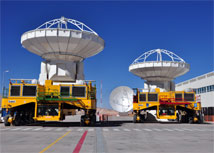Al Wootten

Figure 1. Two antennas constructed by Vertex ride on ALMA transporters at the Operations Support Facility (OSF) in Chile. An antenna constructed by Mitsubishi Electric Corporation (MELCO) is in the background. These three antennas have been conditionally accepted by ALMA and will participate in the first phase closure tests at the high-elevation Array Operations Site (AOS). © ALMA (ESO/NRAO/NAOJ)
 Zoom
Zoom

Figure 2. The ALMA Central Local Oscillator has been successfully installed at the 5000m AOS Technical Building. Photo: W. Grammer.
 Zoom
Zoom
Interferometry continued with the first two ALMA antennas at the Operations Support Facility (OSF) in northern Chile, with refinements to the baseline and to the system. Total power tests occurred on the third antenna, soon to include spectral line pointing using a second single baseline correlator that was delivered from the NRAO Technology Center in Virginia. This instrument had been used at the ALMA Test Facility last year.
The majority of the parts for sixteen ALMA antennas are now at the OSF. The Early Science array is projected to consist of sixteen antennas; it will most likely consist of an array of the antennas now present in Chile.
At its highest operating frequencies, ALMA performance is constrained by the atmosphere and by antenna performance. With three antennas under ALMA testing and thirteen more at the OSF in line for acceptance, a focus of activity has been to ensure that the antennas perform well. To achieve this, both antenna surface accuracy and pointing must be very well understood. Teams from the Joint ALMA Observatory (JAO) and from the ALMA Executives have performed a variety of tests on accepted antennas and on those still in the contractor areas that will soon move through acceptance. An ALMA transporter will soon move an antenna from the OSF to the 5000m Array Operations Site (AOS) for the first high-altitude trials. Preparation for this event has driven a number of activities at the AOS. The water vapor radiometers delivered by ESO were characterized at the OSF and at the AOS, for example, and they have been mounted on two ALMA antennas, where testing continues.
Another example has been the installation of equipment in the AOS Technical Building. A major technical challenge for ALMA has been the provision of a stable Local Oscillator (LO) signal over the wide range of ALMA operating frequencies, keeping the relative phase sufficiently stable after delivery of the signal to different antennas that may be separated by several kilometers. The specification for phase drift is that it be maintained within 2 parts in 1010! This is the job of the Central LO, the first unit of which, capable of providing signals to 16 antennas, has been installed at the 5000m ALMA site.
For the LO, a reference frequency is generated as the difference between two laser signals generated in the infrared portion of the spectrum, at 1.5 microns. The frequency of one laser, the slave, is varied to produce the desired frequency at the antenna when mixed with the frequency of a master laser, both of which are located in the Array Operations Site Technical Building. The phase stable laser difference signal is used to phase-lock a signal generated locally at the antenna that in turn drives the signal for the mixers in the Front End. The phase drift and phase noise must be kept within stringent limits. The phase stability at the antenna is guaranteed by phase locking on the optical fringe, so the number of optical wavelengths must be kept constant over the round trip in the optical fiber. This effectively keeps the electrical length of the fibers, laid underground from the central building to each distant antenna, constant, and so guarantees a constant propagation delay and stable phase at each antenna even at the shortest wavelength (0.32mm) used by ALMA.
The first racks of the ALMA Central LO, which handle sixteen antennas, successfully underwent Provisional Acceptance In-House (PAI) at the NRAO Technology Center on June 24, 2009. The performance of the first unit was verified, and it was packed and shipped to the ALMA site. Upon arrival, the racks were assembled and cabled by W. Grammer, J. Meadows, J. Shelton, and J. Castillo, working in the oxygenated atmosphere of the AOS Technical Building. Bill Shillue, J.F. Cliche, Jason Castro, and Yoshi Masui have conducted on-site testing. Rodrigo Brito has provided invaluable logistical and technical assistance on-site to both teams. Recently the testing team verified passage of an 84 GHz LO signal between the newly installed racks and antenna pad No. 106, just outside the building, onto which an antenna will be moved during September. The lasers have tuned and locked reliably and the phase correction system is working well.
Integration into the ALMA computing system is also going well, allowing monitoring of phase drift data from San Pedro and, eventually, worldwide. The system will next undergo Provisional Acceptance on Site (PAS) and will be used for interferometry at the AOS in the coming months.

 Zoom
Zoom